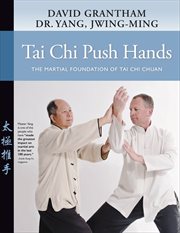Nonfiction
eBook
Details
PUBLISHED
Made available through hoopla
DESCRIPTION
1 online resource
ISBN/ISSN
LANGUAGE
NOTES
Push Hands is the "other" part of tai chi that makes your practice a true living art Tai chi push hands practice is a necessary next step for tai chi practitioners who wish to make their art come alive. Push hands practice requires two people to engage in a variety of "light touch" moving and walking routines. By practicing these movements, practitioners begin to develop tai chi's sensing, listening, and yielding skills. Combined, these skills are the first step for developing your tai chi as a martial art. The Dao De Jing classic reminds us that knowing others (an opponent) is required for knowing ourselves. By develop tai chi push hand skills, one begins to develop a profound sense of feeling of ones' body and mind. This ability aids greatly in controlling body, balance, health, perseverance, compassion, and overall spirit. It is no mistake that tai chi offers a lifetime of continued learning and progress; the goal is a deep understanding of yourself and your role in nature. In this book, you will learn - The theory of tai chi pushing hands - Tai chi qigong foundation practice - Tai chi jing (power) practice - Two-person stationary push hands practice - Two-person moving push hands practice - Tai chi rollback and press push hands practice - International standard push hands routine - Two-person free style push hands - Martial art applications in tai chi push hands practice Dr. Yang reminds us "tai chi chuan was created based on the martial applications which were used for self-defense. Every movement of tai chi chuan has its unique martial purpose. Without this martial root, tai chi chuan practice will limited to a dance, lacking a deeper meaning or a deeper feeling."/p>
Mode of access: World Wide Web







